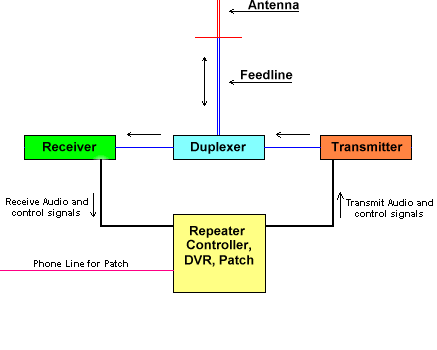
Repeater Questions and Answers
What is a repeater?
A repeater is in concept a rather simple device. It listens on one frequency, then re-transmits what it hears on another. These machines are usually located in high-up places and are equipped with efficient antennas, extremely low loss feedlines, and a power amplifier for the transmitter. The end result? People using a repeater get much longer range from their radio equipment than would be possible talking simplex (point to point without a repeater). This is how an individual with a handheld transceiver can easily communicate with people many miles away and still have a low noise floor and great clarity.
How does it work?
A repeater might appear complicated at first, but if we take it one piece at a time it's really not so tough. A basic repeater consists of several individual 'blocks' that when connected, form a functional system. Here's a simple block diagram:

Antenna
The antenna serves to both transmit and
receive the RF (Radio Frequency) signal that is going in to and out of
the repeater. It's generally a high performance, durable, and rather efficient
antenna located as high on a tower as we can get it. Antenna systems of
this type can easily cost $1000 or more.
Feedline
The feedline on most repeaters isn't
just a piece of standard coax cable, it's what's called 'hard line'. This
stuff is more like a pipe with a center conductor than a cable. It's hard
to work with and expensive. So why do we use it? Performance! The signal
loss is much lower in hard line than in standard cable, so more power gets
to the antenna and weaker signals can be received. Remember, the signal
at a repeater site doesn't just travel a few feet to an antenna like in
a mobile rig. It goes hundreds of feet up the tower to the antenna. Just
for fun check out the specs on a roll of coax some time and see how many
dB of loss you'll get from 200 feet of cable. Hard line also tends to be
more durable than standard cable, which increases reliability and helps
us minimize tower climbs to replace it.
Duplexer
This device serves a critical role in
a repeater. To make a long story short, the duplexer separates the incoming
signal from the outgoing and vice versa. Even though the repeater's input
and output frequencies are different, the duplexer is still needed. Why? Have you ever been in a place where there's lots of RF activity, and
noticed the receive performance of your radio degrades to some degree?
This is called de-sense, and it's a Bad Thing. The receiver gets hosed
up from the strong RF signals being radiated in its vicinity and confused
about which signal it should receive. The result is poor receive quality,
or in extreme cases, lack of receive capability. Keep in mind that in this
example, the radios are picking up radiated power from one another and
that's enough to cause trouble. Now imagine how much trouble there will
be if you not only have the transmitter and receiver close together, but
connect them to the same antenna! Transmitting only a few hundred kHz away
in frequency would blow away the input to the receiver. That's where the
duplexer comes in. It prevents the receiver and transmitter from 'seeing'
one another on the antenna.
Receiver
Receives the incoming signal. This receiver
is generally a sensitive one which helps weaker stations to get into the
repeater with a good signal. It's also where CTCSS (Continuous Tone Coded
Squelch System) decoding takes place.
CTCSS, or 'tone' or 'PL tone', is a sub-audible tone that's sent out by
a repeater user's transceiver. This is used to help the repeater discern
between a person who wants to use it, and spurious RF noise or intermod
interference. The general thinking is "If the squelch gate is open, and
there's a PL tone detected, then it's probably a Ham and not just noise".
Many repeaters use this system with good results including the NARA machines.
Most (if not all) NARA machines use a 100Hz tone.
Controller
This is the brain of the repeater.
It handles station ID (through either CW or the "Romeo" voice), activates
the transmitter at the appropriate times, controls the autopatch, and sometimes
does many other things. The 147.180 and 146.940 machines also have a DVR
(Digital Voice Recorder) for announcements and messages. The controller
is a little computer that's programmed and optimized to control a repeater.
The various models of controllers have different useful features like speed-dial
for phone patches, a voice clock, facilities to control a remote base,
etc. The controller gives the repeater its 'personality'. Whenever you're
using a repeater, you're interacting with its controller.
Transmitter
The NARA machines have a transmitter
composed of an 'exciter' and a power amplifier. The exciter modulates the
audio at the proper transmit frequency, and the power amplifier simply
boosts its level so the signal will travel further.
Repeater Operation
Operating using a repeater isn't difficult. A good source of info is the ARRL Repeater Directory. It's an inexpensive book with repeater listings all over the US. It contains frequency, offset and whether the repeater is + or - shift, and whether or not it requires a PL tone. The ARRL directory also has a great section in the front regarding proper, legal, and courteous operation that would be of great value for all hams, both new and old, to read once in a while. For the local Huntsville area, there's a list here as well.